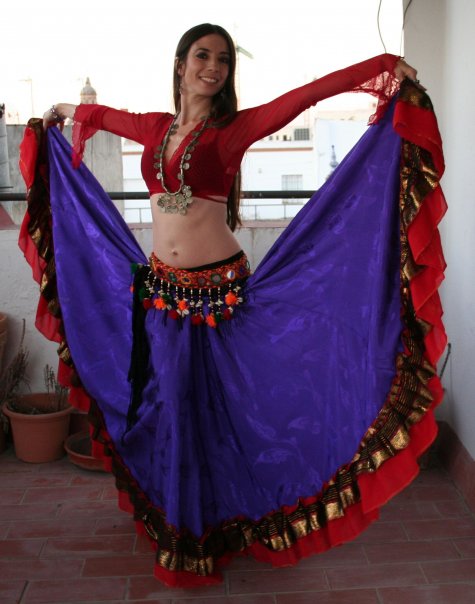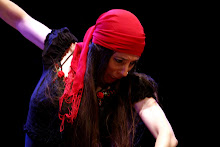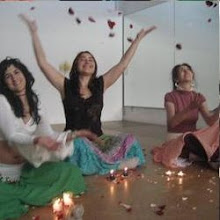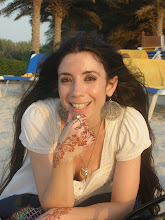Ana Dancing in Kuwait

Ana Otero (Madrid, Spain)
Ana Otero (Madrid, Spain)
PHD Dance Ethnologist
As long as Ana can remember, dance has always been a part of Ana’s life. At an early age she started studying classical ballet, Flamenco and Spanish Dance in Madrid. Ana Otero later went to University in Miami to study Dance and Literature.
At university she met Miriam Eli and enrolled in her Middle Eastern Dance class at Florida International University. Ana considers Miriam as her soul teacher because not only did she learn the beautiful and complicated technique of this dance from her, but also its history. Miriam also taught her the importance of folklore in the Arab world and introduced her to sufism and Persian Sacred Dances.


After University she went back to Madrid, Spain. She immediately was hired to perform in Poland with the Theatre company Lomvriz. After touring Poland she decided to settle in her home town Madrid and focus on teaching. She taught in Escuela de Baile El Horno in Madrid. In her journey as a dance teacher and choreographer, she taught Flamenco and Middle Eastern Dance. She eventually developed a style wich she called Duendel Dance which was a fusion of Contemporary, Flamenco and Oriental/Gypsy Dance forms. She later met Shokry Mohammed (Egypt) and studied in his Middle Eastern Dance School (Escuela de Danza Oriental Pirámides) for 4 years. There she studied Classical Egyptian, Raqs Sharki, as well as Turkish styles and Persian Sacred Dances. Shokry and Ana began a journey which they called Al Andalus, having Ana a Flamenco backround, both of their passions became to reinvent the dance of Al Andalus, the dance in Spain as danced by the muslims, jews, christians and gypsies living together in perfect harmony. Ana soon became a dancer in his company and performed in Shokry Mohammed's theatrical shows throughout Spain. Her interest in Oriental dance has taken her to Turkey to study Turkish Gypsy Dance and to Cairo.


Ana slowly started working towards her PHD in Dance Ethnology, which she happily finished, and soon realised that inside of her dance studios, her students found a home, they found a comfort, and she started to teach dance on a more spiritual level. Ana believes that through dance not only do we acquire a sense of wholeness and happiness, but we also become more aware of our bodies. She started incorporating a yoga (Ana is a certified yoga instructor) based workout, breathe and movement synchronization exercises and meditation. Soon, her dance class was more than technique and choreography, it became a spiritual awakening for her students and herself.


Ana has lived and taught in Egypt, Kuwait and Dubai. She has learned from many masters from the Arab world and from India.


Many of Ana's masters: Cristiane Azem, Eva Chacón, Julia Salmerón, Gloria Alba, Tatiana, Mahmoud Reda, Rakia Hassan, Nabil Mabrouk, Fátima Fontes, Myriam Szabo, Souhaila Salimpour, Tito and Ansuya, Bettinal Castano, Manuela Reyes, Belen Maya, Faruk Mustafa, Mona Mustafa, Nasra, Freiz, Sameh el Dessouki, Ashraf Hassan, Chua Alba, Manolete, Judea Maya, Isabel Bayón, Rafael Campallo, Raquel Molina.
Ana and yoga:
Ana Otero received her first certification with Swami Sivananda and lived in the Sivananda Ashram in Zaragoza, Spain, for three months. She later received the European Association of Yoga Degree (3 year degree). Her great Masters in Spain have been Ramiro Calle and Margot Paccuad, and she has studied with many other Masters from the United States and India. She has also taken workshops with different masters around the world. Ana teaches a variety of styles: Hatha, Iyengar,Ashtanga, Jivamukti (a mix of these 3), Vinyasa and Kundalini. She has also created a new yoga philosophy which she calls Kundalini Shakti Dance, which is a fusion of yoga and dance, the main objective being to wake up the Kundalini energy which lies dormant in the base of the spine and to balance out the chakras. This Dance, just as in yoga, is centered in the breathing. Movement and breath synchronizing to create the state of a moving meditation.
Ana's yoga classes focus on Mind, Body and Spirit working in unison throughout the practise. Her warm up exercises in class consist of Pranayama Breathing and Kundalini practise to warm up the spine. At the end of each session she places great importance on savasana, relaxation, and offers a reiki message to her students.www.anaoteroyoga.blogspot.com
In addition to my artistic vision of dance and to my artistic needs as a performer, I am now keenly interested in the therapeutic and life-saving powers of dance and I want to help dancers and people in general to “Dance the Dance of Life!” I work with students, not only to improve technique and skill, but to travel into their inner spirit to get to the ‘soul of the dance’ . I use dance to express emotion, have fun, build strength and confidence, to improve physical and emotional health and ultimately, send out positive energy and beauty into the world.
Ana Otero

PHD Dance Ethnologist
As long as Ana can remember, dance has always been a part of Ana’s life. At an early age she started studying classical ballet, Flamenco and Spanish Dance in Madrid. Ana Otero later went to University in Miami to study Dance and Literature.
At university she met Miriam Eli and enrolled in her Middle Eastern Dance class at Florida International University. Ana considers Miriam as her soul teacher because not only did she learn the beautiful and complicated technique of this dance from her, but also its history. Miriam also taught her the importance of folklore in the Arab world and introduced her to sufism and Persian Sacred Dances.
After University she went back to Madrid, Spain. She immediately was hired to perform in Poland with the Theatre company Lomvriz. After touring Poland she decided to settle in her home town Madrid and focus on teaching. She taught in Escuela de Baile El Horno in Madrid. In her journey as a dance teacher and choreographer, she taught Flamenco and Middle Eastern Dance. She eventually developed a style wich she called Duendel Dance which was a fusion of Contemporary, Flamenco and Oriental/Gypsy Dance forms. She later met Shokry Mohammed (Egypt) and studied in his Middle Eastern Dance School (Escuela de Danza Oriental Pirámides) for 4 years. There she studied Classical Egyptian, Raqs Sharki, as well as Turkish styles and Persian Sacred Dances. Shokry and Ana began a journey which they called Al Andalus, having Ana a Flamenco backround, both of their passions became to reinvent the dance of Al Andalus, the dance in Spain as danced by the muslims, jews, christians and gypsies living together in perfect harmony. Ana soon became a dancer in his company and performed in Shokry Mohammed's theatrical shows throughout Spain. Her interest in Oriental dance has taken her to Turkey to study Turkish Gypsy Dance and to Cairo.


Ana slowly started working towards her PHD in Dance Ethnology, which she happily finished, and soon realised that inside of her dance studios, her students found a home, they found a comfort, and she started to teach dance on a more spiritual level. Ana believes that through dance not only do we acquire a sense of wholeness and happiness, but we also become more aware of our bodies. She started incorporating a yoga (Ana is a certified yoga instructor) based workout, breathe and movement synchronization exercises and meditation. Soon, her dance class was more than technique and choreography, it became a spiritual awakening for her students and herself.
Ana has lived and taught in Egypt, Kuwait and Dubai. She has learned from many masters from the Arab world and from India.


Many of Ana's masters: Cristiane Azem, Eva Chacón, Julia Salmerón, Gloria Alba, Tatiana, Mahmoud Reda, Rakia Hassan, Nabil Mabrouk, Fátima Fontes, Myriam Szabo, Souhaila Salimpour, Tito and Ansuya, Bettinal Castano, Manuela Reyes, Belen Maya, Faruk Mustafa, Mona Mustafa, Nasra, Freiz, Sameh el Dessouki, Ashraf Hassan, Chua Alba, Manolete, Judea Maya, Isabel Bayón, Rafael Campallo, Raquel Molina.
Ana and yoga:
Ana Otero received her first certification with Swami Sivananda and lived in the Sivananda Ashram in Zaragoza, Spain, for three months. She later received the European Association of Yoga Degree (3 year degree). Her great Masters in Spain have been Ramiro Calle and Margot Paccuad, and she has studied with many other Masters from the United States and India. She has also taken workshops with different masters around the world. Ana teaches a variety of styles: Hatha, Iyengar,Ashtanga, Jivamukti (a mix of these 3), Vinyasa and Kundalini. She has also created a new yoga philosophy which she calls Kundalini Shakti Dance, which is a fusion of yoga and dance, the main objective being to wake up the Kundalini energy which lies dormant in the base of the spine and to balance out the chakras. This Dance, just as in yoga, is centered in the breathing. Movement and breath synchronizing to create the state of a moving meditation.
Ana's yoga classes focus on Mind, Body and Spirit working in unison throughout the practise. Her warm up exercises in class consist of Pranayama Breathing and Kundalini practise to warm up the spine. At the end of each session she places great importance on savasana, relaxation, and offers a reiki message to her students.www.anaoteroyoga.blogspot.com
In addition to my artistic vision of dance and to my artistic needs as a performer, I am now keenly interested in the therapeutic and life-saving powers of dance and I want to help dancers and people in general to “Dance the Dance of Life!” I work with students, not only to improve technique and skill, but to travel into their inner spirit to get to the ‘soul of the dance’ . I use dance to express emotion, have fun, build strength and confidence, to improve physical and emotional health and ultimately, send out positive energy and beauty into the world.
Ana Otero
miércoles, 20 de febrero de 2008
Ana Otero
BELLY DANCE
Bellydance is one of the worlds oldest dances and originates in what is today considered the Arabic world. Although the movement language used in bellydance is consistent through out the Middle East, variations of characteristic stylings are equated with specific regions. Most U.S. dancers do not dance any pure form of the dance but a fusion of stylings –American Style Bellydance.
Bellydance (sometimes referred to as the original sacred women's dance) was originally practiced as a social activity among women -a favorite pastime promoting holistic wellbeing. The movements in bellydance mimics movements, cycles and patterns found in nature. It is thought that our earliest ancestors moved there bodies in ways that mimicked mother nature's as a way of celebrating their spiritual and physical connection to her. There is an earthiness to bellydance that is distinctly different from the styles of dance westerners are accustomed to seeing. In Dances such as ballet, jazz and modern dance, the emphasis is on the limbs of the body and there is a distinct effort placed on escaping gravity. In belly dance, the dance is about the body rather than the limbs and our gravitational connection to the earth is celebrated. This is clearly visible in the look of the dance. Bellydance is rooted in natural movement.
Bellydance has continued to evolve over a span of literally thousands of years and continues to be practiced as a favorite social activity among the women of today all over the world. The bellydance of today still reflects the reverence our ancestors had for Mother Earth and her creations.
Bellydance and the Chakras
The chakras form the seven basic energy centers in the body, each of which correlates to major nerve ganglia branching forth from the spinal column. When energy flows smoothly and cleanly through the chakras, the body's vitality increases.
The 7th chakra is located at the crown of our head. When open, it brings us knowledge, wisdom, understanding, spiritual connection, and bliss. The belly dance movement that stimulates this energy center is the meditative subliminal head circle.
The 6th chakra is located at the third eye center. It is related to the act of seeing, both physically and intuitively. When healthy it allows us to see clearly, in effect, letting us "see the big picture." The belly dance movement that stimulates this energy center is the sight circle, a head circle centered on the eyes performed while focusing our sight and consciousness on the direction of movement.
The 5th chakra is located in the throat and relates to communication and creativity. The belly dance isolation that stimulates this chakra are the shoulder isolations which free up our voices and breath to sing.
The 4th chakra is called the heart chakra. It is related to love and the nexus between the physical and the spiritual. The belly dance moves that stimulate the fourth chakra are the chest isolations.
The 3rd chakra is known as the power chakra, located in the solar plexus. It rules our personal power, will, and autonomy, as well as our metabolism. Stomach & abdominal isolations stimulate this chakra.
The 2nd chakra, located in the abdomen, lower back, and sexual organs, is related to emotions and sexuality. The belly dance move that we use to stimulate this chakra are upper pelvic circles & kegels
Located at the base of the spine, the 1st chakra forms our foundation. It is related to our survival instincts, and to our sense of grounding and connection to our bodies. Hip isolations stimulate this chakra.
Health Benefits of Bellydance
Bellydance is an ancient form of exercise designed to strengthen and tone women's core muscles, arms, and legs. Belly dancing is extremely low impact and very fun and energizing. For those looking to lose weight, its caloric effect is roughly comparable to that of a low-impact aerobics class. Yet bellydance is a lot of fun and most students feel energized and happy when they finish class.
In bellydance, the knees should always be flexed. Hip and torso isolations in this position strengthen the quadriceps, glutes, and calves as well as the muscles that stabilize the knees and ankles. All of this is accomplished with virtually no impact to the joints. Also, the knee flexion and relaxation of the pelvis required for most isolations relieve stress that can occur in the lower back, placing it firmly on the quads, which strengthen to handle it.
The back muscles are also exercised evenly in bellydance. Hip, torso, shoulder, and head isolations exercise and coordinate all of the muscles in the back in a gentle, controlled fashion. As the back is worked out, so too are the muscles in the front and sides of a woman's body. Muscle development is even throughout the woman's core and posture will gradually improve under the guidance of a conscientious teacher.
As an added benefit, bellydance greatly strengthens the abdominal and corset muscles, which frequently translates to a narrower waistline.Bellydance has traditionally been regarded by tribal societies as good exercise to prepare women for pregnancy and childbirth. In women who have had children, substantial restoration of abdominal tone can be accomplished through bellydance. Some assert that gastric and metabolic functions can also be improved through bellydance.
Shoulder isolations are known to massage the thyroid just as core isolations massage the gastro-intestinal and reproductive tracts. One of the biggest surprises people find in bellydance is how strong their arms must become in order to support the graceful, flowing moves that characterize the dance! Veil work, in particular, gently works the triceps, shoulders, and biceps. The traditional "snake arms" further develop the triceps, creating surprisingly strong, well-formed arms.
Overall, belly dancing strengthens and tones the entire woman's body slowly and evenly with very little impact. Belly dancing is a gift to all women and its practice can, over time, effectively tone your body into its personal, optimal physical shape. This is true regardless of your body type or skeletal proportions. Arms become stronger, posture improves, bellies tighten, legs and glutes strengthen and grow. There is no one "type" of body that's right for bellydance. It is designed to benefit all women's muscular, physical structures. Plus it's a lot of fun, so try it out and see for yourself what it can do for you!
Suscribirse a:
Entradas (Atom)